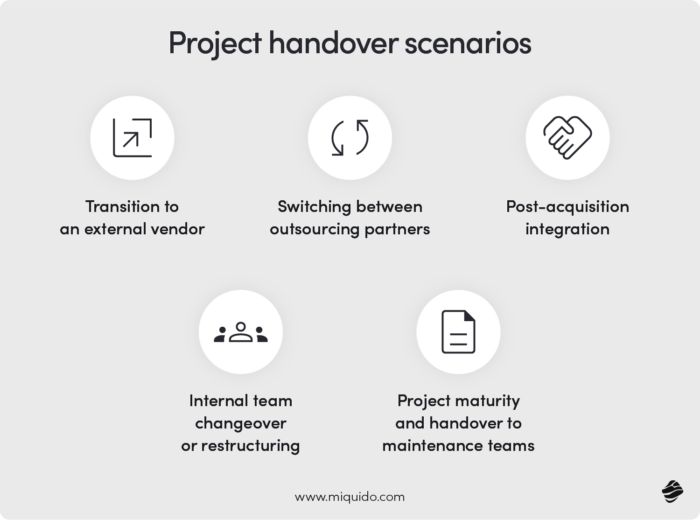Handing a software project is a critical phase in ensuring the project’s continuity, quality, and long-term success. Whether the handover is to a new internal team, an outsourced provider, or the client, using a project handover template can prevent knowledge, quality, or support gaps. As a software development company with over 13 years of experience, we prepared this detailed checklist to execute a successful software project handover and achieve a seamless transition.
What is project handover?
Project handover is a vital stage in project management where control, responsibility, and ownership of a project are formally passed to another person or organization. This shift can be temporary, as in cases where a team member covers for someone on leave, or it can be permanent, such as when a project is transitioned to a new department or an external partner.
The length of the handover process depends on the project’s complexity and scope. While some handovers may be completed in a few weeks, others may require several months to ensure a seamless transfer of responsibilities and preserve the project’s success. Understanding the project’s objectives is crucial for a seamless transfer of responsibilities and preserving the project’s success. In all cases, using a structured project handover checklist greatly enhances the likelihood of a smooth transition.
When and why does software project handover matter?
There are various scenarios when you may need to hand over a software project, such as transitioning from an in-house development team to an external vendor, switching between outsourcing partners, or integrating a newly acquired team’s project into existing operations. These transitions often arise due to strategic shifts, performance issues, or the need for specialized expertise. Challenges during handovers include potential knowledge loss, miscommunication, and integration difficulties, which can disrupt project continuity and affect quality.
However, effective handovers can lead to benefits like enhanced efficiency, access to specialized skills, and improved project outcomes. According to a report by the Association for Project Management (APM), 85% of respondents agreed that clearly established and communicated project benefits are crucial for successful handovers, while 75% emphasized the importance of end-user representation throughout the project lifecycle.

1. Transition to an external vendor
When a company decides to outsource a project, either due to resource constraints or the need for specialized skills, a handover is essential to ensure the new vendor understands the project’s objectives, technical details, and current status. This can help streamline the transition, though challenges often include transferring sufficient project knowledge and aligning on quality standards. The benefit is access to a larger talent pool with specialized expertise, which can speed up development and improve quality.
2. Switching between outsourcing partners
If you are unsatisfied with the performance of a current outsourcing partner, a software development company or seeks better cost efficiency, switching vendors requires a thorough project handover to prevent service disruptions. Key challenges here include the risk of losing project history and inconsistencies in workflow, but a well-executed handover allows for a smooth transition, retaining project integrity and potentially boosting performance with a more compatible vendor.
3. Internal team changeover or restructuring
Internal restructuring, such as employee turnover or team reorganization, can necessitate a handover to maintain continuity within a project. Transitions between internal teams often happen when a project moves from development to maintenance or when a project scales and requires additional resources. A challenge here is the potential for knowledge gaps if documentation and knowledge transfer are insufficient, but the benefit is continuity within the company, allowing for better alignment with long-term business goals.
4. Post-acquisition integration
In cases of mergers and acquisitions, companies often need to integrate acquired software projects into their existing frameworks. This handover can be complex due to differences in technology stacks, documentation standards, and workflows. However, a successful handover allows companies to merge resources effectively, avoid redundancies, and leverage the acquired technology to add value to their product portfolio.
5. Project maturity and handover to maintenance teams
When a project is completed, transitioning from the development team to a dedicated maintenance team ensures that resources are effectively managed and ongoing support is provided. The challenge here lies in ensuring the maintenance team fully understands the project’s nuances to respond to issues swiftly. A successful handover promotes long-term project stability and allows the original development team to focus on new initiatives.
The role of a project manager in project handover
A project manager plays a crucial role in ensuring a smooth project handover. Their primary responsibility is to oversee the entire handover process, ensuring that all necessary steps are taken to transfer ownership of the project to the new team or client. This includes:
- Coordinating with team members: Gather all relevant project information and documentation to ensure nothing is overlooked.
- Developing a comprehensive project handover plan and checklist: This plan should outline all tasks, timelines, and responsibilities to ensure a structured and efficient handover process.
- Communicating with stakeholders: Ensure a clear understanding of the project’s status, objectives, and any potential risks or issues.
- Facilitating knowledge transfer and training: Organize sessions to equip the new team or client with the necessary knowledge and skills to take over the project.
- Ensuring project deliverables are complete: Verify that all deliverables meet the required standards and are ready for handover.
- Obtaining formal sign-off: Secure confirmation from the client or stakeholders to officially mark project completion.
Effective leadership and communication skills are essential for a project manager to navigate the complexities of the handover process. By coordinating efforts and ensuring thorough knowledge transfer, project managers can facilitate a seamless transition and maintain project continuity.
Where to start? Essential software project handover checklist
In software development, project handovers often involve knowledge transfer, access permissions, security protocols, and technical documentation. A well-structured checklist helps:
- Ensure continuity without losing project momentum.
- Maintain quality standards and minimize technical debt.
- Provide ongoing support to safeguard the project’s long-term success.
Comprehensive handover checklist
| Checklist item | Description | Check |
|---|---|---|
| 1. Documentation essentials | Collect all project documentation: code documentation, architecture diagrams, deployment guides, and user manuals. | ☐ |
| 2. Knowledge transfer sessions | Conduct walkthrough sessions for the incoming team to discuss the codebase, key decisions, and potential risks. | ☐ |
| 3. Technical architecture overview | Review and document architecture, infrastructure, third-party integrations, and deployment pipelines. | ☐ |
| 4. Source code and repository access | Hand over all version control access, repository branches, and codebase backups. | ☐ |
| 5. Development environment setup | Provide setup instructions for development, staging, and production environments, including server credentials. | ☐ |
| 6. Testing and quality assurance | Deliver detailed testing documentation, including test cases, QA processes, and testing workflows. | ☐ |
| 7. Security protocols and compliance | Document security protocols, API keys, compliance documents, and data protection measures. | ☐ |
| 8. Role assignments and permissions | Assign appropriate permissions for project management tools, repositories, CI/CD tools, and cloud platforms. | ☐ |
| 9. Support and maintenance agreement | Define support and maintenance terms, such as SLAs, for post-handover issue resolution. | ☐ |
| 10. Handover documentation template | Create a handover checklist template for easy replication in future projects. | ☐ |
Detailed breakdown of key handover checklist items
1. Documentation Essentials
Clear, detailed, and organized documentation is the backbone of an effective handover. Ensure all project-related documents, including:
- Code documentation: Describe core functionality, modules, and logic within the code.
- Architecture diagrams: Visual overviews of system architecture, data flow, and integrations.
- User manuals and deployment guides: Provide end-user instructions and deployment steps.
To ensure a smooth project handover, it’s crucial that tender documents and contracts specify all requirements with as much precision as possible. This includes outlining engagement expectations, data environments, and any equipment or product standardization you require. The more accurately these details are defined upfront, the more likely the final deliverables will meet your expectations while minimizing unexpected costs. By focusing on asking the right questions in this phase, rather than dictating specific solutions, the handover process can better support evolving benefits throughout the project lifecycle.
2. Knowledge transfer sessions
Facilitating knowledge transfer sessions is crucial for onboarding the incoming team. Use these sessions to walk through the codebase, highlight key decisions, and address:
- Technical debt: Discuss known issues, future considerations, and potential challenges.
- Codebase structure: Explain code organization, major modules, and significant dependencies.
- Operational risks: Flag any limitations or risks that may impact future development.
3. Technical Architecture Overview
A well-documented technical architecture provides the incoming team with a foundational understanding of:
- Infrastructure: Outline server setups, network configurations, and hosting requirements.
- Third-party integrations: Note any external services or APIs connected to the project.
- Deployment pipelines: Document CI/CD processes and necessary tools.
4. Source Code and Repository Access
Proper access to the codebase ensures continuity and reduces downtime:
- Version control: Hand over all version control repositories and branching strategies.
- Repository organization: Ensure documentation covers the structure and purpose of each branch.
- Backups: Provide regular backups and recovery instructions for safety.
5. Development Environment Setup
A critical handover component is setting up all necessary environments:
- Development, staging, and production environments: Document configuration and access details.
- Database configurations: Include environment variables and server credentials.
6. Testing and quality assurance
A quality-focused handover includes thorough QA documentation:
- Test cases: List all test cases with expected outcomes.
- QA process overview: Explain testing workflows, tools, and any automated testing.
- Bug history and unresolved issues: Provide details on bugs encountered during development.
7. Security protocols and compliance requirements
Security should be a top priority during handover. Ensure that the incoming team has access to:
- Security protocols: Hand over API keys, authentication processes, and encryption standards.
- Compliance documents: Include GDPR, HIPAA, or other compliance documents and guidelines.
8. Role Assignments and access permissions
Managing role assignments across tools and platforms helps maintain project security:
- Tool permissions: Assign roles for project management tools, repositories, CI/CD tools, and cloud services.
- Access logs: Track and document all permissions to manage roles effectively.
Identify and understand the project stakeholders who will benefit from the project and those who will play a role in delivering those benefits. Including these end users from the start, even if only at key points, ensures their needs are reflected in project decisions. By involving them strategically, they are more likely to become advocates for the project, aiding its transition to regular operations.
Defining and understanding stakeholders is an ongoing task that extends beyond project transition and into regular operations. Take the time to identify everyone who is impacted by the project and those critical to its success—not just at the transition stage, but also in day-to-day operations. For example, on a construction project, facilities managers and IT support, who may not have a primary role during project development, will play essential roles in regular operations. Avoid relying on a single end-user representative to cover all aspects; a broader perspective ensures more comprehensive outcomes. Aligning these roles with the project’s objectives helps ensure that all team members are focused on meeting those objectives, thus facilitating a smooth transition and promoting successful outcomes.
9. Support and maintenance agreement
An effective support plan can prevent critical issues from slipping through post-handover. Set up:
- Service-level agreement (SLA): Define response times, issue severity levels, and maintenance scopes.
- Communication channels: Establish primary contact methods, support hours, and escalation procedures.
Establishing clear lines of communication helps to avoid misunderstandings and conflicts during the transition process.
10. Handover documentation template
Finally, provide a customizable handover checklist template. This document allows future handovers to follow a structured format, promoting consistency and completeness.
Gathering lessons learned as the project advances provides valuable insights for future projects and can be aligned with key milestones or deliverables. This practice also serves as a decision log, capturing the project’s history in real time, directly from those involved. Staff turnover can lead to knowledge gaps, so capturing these insights regularly prevents information loss over time and serves as a guidance for next projects.
11. Data Backup and Recovery
Data backup and recovery are critical components of the project handover process. A project manager must ensure that all project data is backed up and easily accessible to the new team. This involves identifying and documenting all data storage locations, creating a backup schedule to ensure that data is regularly backed up, and developing a recovery plan in case of data loss or corruption.
Ensuring that all team members and stakeholders have access to the backed-up data is crucial for maintaining project continuity. A well-planned data backup and recovery process can help minimize the risk of data loss and ensure a smooth transition of the project. By implementing robust data management practices, project managers can safeguard the project’s valuable information and support the new team in maintaining project momentum.
Project Handover templates and examples
Project handover templates are essential tools that help project managers ensure a smooth transition of a project from one team to another. These templates provide a structured format for documenting project information, including project objectives, scope, timelines, and deliverables.
Here are some examples of project handover templates:
- Project handover checklist template: This template provides a comprehensive checklist of tasks and activities that need to be completed during the handover process. It ensures that no critical steps are missed and that all necessary information is transferred.
- Project handover plan template: This template outlines a detailed plan for the handover process, including timelines, milestones, and responsibilities. It helps project managers organize and manage the handover efficiently.
- Project handover report template: This template offers a format for documenting project information, including objectives, scope, timelines, and deliverables. It serves as a final report that can be handed over to the new team or client.
Using project handover templates can help project managers ensure that all necessary information is documented and transferred to the new team or client, reducing the risk of errors and delays. These templates provide a clear roadmap for the handover process, promoting consistency and completeness.
Tips for executing a successful project handover
A smooth project handover requires careful planning, coordination, and communication. Here are some best practices to ensure a successful project handover:
Start early and measure the right metrics
Plan the handover process in advance to allow time for adjustments and knowledge transfer. What’s more, clearly defining project goals and measurable outcomes from the beginning is essential. Setting benchmarks and establishing success criteria for both tangible and “soft” benefits, such as user satisfaction or staff retention, allows for consistent tracking. With measurable targets, the project team can manage progress more effectively, as “what gets measured, gets managed.”
Consider the whole project life cost
When possible, decisions should account for the total lifecycle cost of the project, rather than just the initial expenses. Attempts to reduce upfront costs can lead to issues in quality, timeline, and performance over time. Each change should be evaluated from a long-term cost perspective—investing more now may ultimately lower the overall cost of maintaining the project. This approach requires to have the data and resources needed to make informed, auditable decisions.
Maintain transparency
Regularly update all key stakeholders on handover progress, potential issues, and timelines. Ensuring a team of dedicated and skilled professionals remains on the project is one of the most straightforward yet often underestimated aspects of project success. Projects and team dynamics are fluid, and external factors can impact performance or lead team members to exit the project. To mitigate these risks, identify potential issues that may affect team commitment and take proactive measures to address them. Advocate for the team you need and work to retain them.
Treat handover as an ongoing process, not a single event
Effective handovers should be planned from the outset and seen as a gradual transfer of knowledge and responsibility from the project team to regular operations and all parties involved. Rather than a single handover date, incorporate incremental steps—such as sample reviews, simulations, and data readiness tests—throughout the project to ensure a steady and comprehensive transfer and resource management.
Engage end users early and often
The client’s role is crucial—not merely in a “customer is always right” sense, but as an active participant in the project’s success. In interviews, “client” consistently emerged as a key term, referring variously to client engagement, design, budget, and decision-making responsibilities. A successful project team engages the client throughout, using their input for key approvals and to align the project with the client’s overarching goals and expectations.
By understanding the client’s perspective, decision-making hierarchy, and strategic goals, the project team stays aligned with core objectives. Engaging clients early on clarifies their responsibilities, helping prevent scenarios where the client feels they “didn’t get what they paid for.” Instead, they are equipped to support the handover process and ongoing project outcomes effectively.
Ensure knowledge transfer among key stakeholders and new team members
Identify and understand the key stakeholders who will benefit from the project and those who will play a role in delivering those benefits. Including these end users from the start, even if only at key points, ensures their needs are reflected in project decisions. By involving them strategically, they are more likely to become advocates for the project, aiding its transition to regular operations.
By following these best practices, project managers can ensure a smooth project handover, reducing the risk of errors and delays and ensuring that the new team or client is equipped to take over the project successfully. This approach supports long-term project stability and continuity, contributing to the overall success of the project.
The importance of a project handover checklist in software project management
A project handover checklist is a critical tool in software project management. It ensures that all necessary steps are taken to complete the project successfully and that the new team has all the information they need to take over the project. A project handover checklist should include project details and objectives, timelines and milestones, roles and responsibilities, communication and coordination plans, knowledge transfer and training plans, and data backup and recovery plans.
By using a project handover checklist, project managers can ensure that all necessary steps are taken to complete the project successfully and that the new team has all the information they need to take over the project. This can help minimize the risk of errors and delays and ensure a smooth transition of the project. A well-structured checklist not only provides a clear roadmap for the handover process but also helps maintain the project’s integrity and continuity, supporting long-term success.
Common challenges in project handovers
Project handovers can be complex and challenging, and project managers may face several common challenges. These include unclear project objectives and scope, insufficient documentation and knowledge transfer, poor communication and coordination among team members and stakeholders, inadequate training and support for the new team, and unrealistic timelines and expectations. Additionally, when leveraging staff augmentation as part of the project transition, challenges such as integrating external team members and aligning their expertise with project needs can arise.
To overcome these challenges, project managers must be proactive and plan carefully. This includes creating a comprehensive project handover document, facilitating knowledge transfer, and ensuring that all stakeholders are informed and aligned with the project’s status and progress. By addressing these challenges head-on, project managers can ensure a smoother transition and maintain the project’s quality and continuity.









